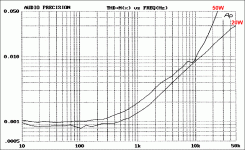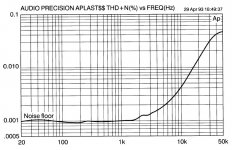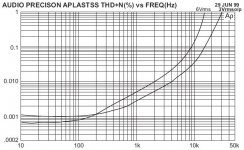I'm talkin' 'bout the typical ferrites as used on billions of power and signal cables.If you put an audio current (i.e. a single wire, not a signal and return pair) through a ferrite then it is conceivable that the non-linear nature of the ferrite could reflect back on the signal. This would mean that the circuit was low impedance and the ferrite has high permeability. This could be the case if you were using the ferrite as an inductor to stop low frequency RF. Bad use of ferrite! To stop low freq RF you need a choke, which either uses ferrite with a good airgap or a dust iron core. To stop high freq RF you can use a lower permeability but higher loss ferrite. As always in engineering, you need to read and understand the datasheets and understand exactly what you are trying to achieve. Simply slapping on a ferrite to an existing circuit may cause problems. That doesn't mean that ferrite is bad for audio; just that poor engineering is bad for audio.
The affect/effect is non zero.You can, however, simply slap a ferrite on a signal and return pair as the audio signal seen by the ferrite is zero.
Dan.
Sorry but have to disagree on BQP, common how can he not understand it.... stretching the imagination somewhat....
The bottom line, as Bybee states, it is that "when developing the technology we did not fully understand why certain metal oxides absorb or damp specific frequencies and to the best of my knowledge we still do not."
IME ferrites on power and/or signal of radio/cd player, shelf system, hifi, PA system, take your pick, affect/effect audio, and not for the better.Regarding ferrites I don't see fears of it affecting other analogue signals (or audio) in other walks of life, strange, but then they don't use BQPs, even stranger!!!😱
Dan.
Quote " . . . The difference between ferrite beads and BQPs though is reality, on is based on reality on is based on BS..... "
So the BS stands for 'Bybee Science' I presume?
So the BS stands for 'Bybee Science' I presume?
IME ferrites on power and/or signal of radio/cd player, shelf system, hifi, PA system, take your pick, affect/effect audio, and not for the better.
Dan.
😕
In what way and how did you arrive at this?
"That return energy is not linear and I find that such ferrites do affect/effect baseband audio."
At audio frequencies the effect is negligible (i.e. probably not measurable on an AP or on frequency response.
Its double blind test time.
Last edited:
and not for the better.
Can you explain why your experience differs so much, compared to quite a few reputable manufacturers ?
IME ferrites on power and/or signal of radio/cd player, shelf system, hifi, PA system, take your pick, affect/effect audio, and not for the better.
Dan.
Dan,
I am convinced you are hearing things that are not there as in, cannot be discerned by ear. This is not the first time I noticed your doing so. And this is not the first time I am calling for some kind of proof. In order to make statements like this stand, you need at least to elaborate the kind of testing you did to come to such conclusions.
Metals come in all sorts of alloys... same with ferrites and metal-ceramic types. The alloying determines the freq of effective Z and q and other parameters....
such as, hysteresis which has similar affect as DA in a cap.
The German cores made of Aronit (cer-met) material and also Ferrite core HP3616 could be a good choice to try.
THx-RNMarsh
such as, hysteresis which has similar affect as DA in a cap.
The German cores made of Aronit (cer-met) material and also Ferrite core HP3616 could be a good choice to try.
THx-RNMarsh
Last edited:
What got me to look at the higher than audio freq was a high THD+N reading with an 80KHz BW analyzer filter.... well within most SS amps BW. IIRC, -60-65dB re 0dbm when measuring a 10KHz signal via playback.
All looks good with THD or FFT esp with 30KHz filtering...... but unwanted freq above 30KHz are easily amplified by the pre and power amps to their BW limit. This can easily lead to increased distortion in the audio freq range.
As an alternative idea to filtering, low amplifer distortion measured to 100KHz might help. Is this a contributing reason why CFA sound better in most systems?
THx-RNMarsh
All looks good with THD or FFT esp with 30KHz filtering...... but unwanted freq above 30KHz are easily amplified by the pre and power amps to their BW limit. This can easily lead to increased distortion in the audio freq range.
As an alternative idea to filtering, low amplifer distortion measured to 100KHz might help. Is this a contributing reason why CFA sound better in most systems?
THx-RNMarsh
Last edited:
Yes, IMD on wideband amplifiers is a reason it's sensible to bandwidth limit the input/outputs of an amplifier.
Integrating over 2.666x the bandwidth will also, unsurprisingly, increase the noise figure handsomely, especially depending on the compensation scheme of the amplifier (HF noise gain around the intercept for stability). Will any of it be audible?
As Bonsai writes, back to the DBT before handwringing.
And a preemptive happy Thanksgiving to our US members, and equal goodwill to everyone around the globe.
Integrating over 2.666x the bandwidth will also, unsurprisingly, increase the noise figure handsomely, especially depending on the compensation scheme of the amplifier (HF noise gain around the intercept for stability). Will any of it be audible?
As Bonsai writes, back to the DBT before handwringing.
And a preemptive happy Thanksgiving to our US members, and equal goodwill to everyone around the globe.
What got me to look at the higher than audio freq was a high THD+N reading with an 80KHz BW analyzer filter.... well within most SS amps BW. IIRC, -60-65dB re 0dbm when measuring a 10KHz signal via playback.
All looks good with THD or FFT esp with 30KHz filtering...... but unwanted freq above 30KHz are easily amplified by the pre and power amps to their BW limit. This can easily lead to increased distortion in the audio freq range.
Noise shaping? DSD? (both have HF noise that confuses measurements) Or some historical amplifiers? Otherwise I have no explanation.
Integrating over 2.666x the bandwidth will also, unsurprisingly, increase the noise figure handsomely, especially depending on the compensation scheme of the amplifier (HF noise gain around the intercept for stability). Will any of it be audible?
.
Note that i am Not talking about noise figure or thermal or 1/f or anything remotely like any of that. This increase is due to extraneous unwanted freqs generated by (digital) circuitry and which appears in the analog output.
THx-RNMarsh
"Unwanted freqs generated by digital" are easily measurable. If the device is not a total s..t, then it is noise shaping. I hope we do not speak about cheap DVD players with poor SMPS power supplies. But even if yes, a good amplifier must handle this easily. If not, then it is a poor design, regardless names.
Last edited:
second graph seems to be levelling out. As for the others, if you have 50W at 50KHz coming out your power amp then you have some major issues on your hands surely?
Ok. So it seems that the digital guys just moved their problem off their desk and onto the next guys.
The freqs above 20Khz must be cleaned up before going to the pre/PA. Either in the DAC/CD player or the next piece of equipment has to deal with it.
High levels above 20Khz can cause problems for the gear following.
View attachment SDModulation.pdf
tests which pretend that only our hearing freq range is needed to measure is deceptive. Critical listeners will hear the whole system working together which includes above audio freqs affects as well as dynamically changing parameters and elements.... neither are showing anything with typical FFT and thd measurements using a pure single, in-band sine wave for individual equipment tested in isolation.
I think I said this before.
THx-RNMarsh
The freqs above 20Khz must be cleaned up before going to the pre/PA. Either in the DAC/CD player or the next piece of equipment has to deal with it.
High levels above 20Khz can cause problems for the gear following.
View attachment SDModulation.pdf
tests which pretend that only our hearing freq range is needed to measure is deceptive. Critical listeners will hear the whole system working together which includes above audio freqs affects as well as dynamically changing parameters and elements.... neither are showing anything with typical FFT and thd measurements using a pure single, in-band sine wave for individual equipment tested in isolation.
I think I said this before.
THx-RNMarsh
Last edited:
For some DIY'ers who might need some filtering, this can be a helpful source to add a LPF to their gear.
http://sim.okawa-denshi.jp/en/CRlowkeisan.htm
THx-RNMarsh
http://sim.okawa-denshi.jp/en/CRlowkeisan.htm
THx-RNMarsh
Last edited:
second graph seems to be levelling out. As for the others, if you have 50W at 50KHz coming out your power amp then you have some major issues on your hands surely?
What's the problem with having 50W at 50 kHz, Bill? Or am I missing something? I assume you have no significant breakthrough of whatever much isn't supposed to be there, although I have witnessed cases of ultrasonic noise leaking out of a cheap CD player, and that could be quite a problem. It was later found that a low pass filter inside was in fact not working due to a leaked out capacitor, and set straight by replacement, removing the worst of the problem.
No such problems with the real time DAC (8 parallel Philips 1543 DACs, no oversampling, no usual brick wall filters, just some classic analog first order filters), although I can hardly claim much on basis of just one (Australian) sample, delivering truly high quality sound. Worth every penny it cost (AU$ 250) and then some.
Seems like a paradox to me. Here we are, trying to avoid every bit of phase shift we can inside the amp, which means it must have a very wide bandwidth, and on the other hand this very act appears to be a possible trap which creates more problems than it resolves.
- Status
- Not open for further replies.
- Home
- Member Areas
- The Lounge
- John Curl's Blowtorch preamplifier part II


